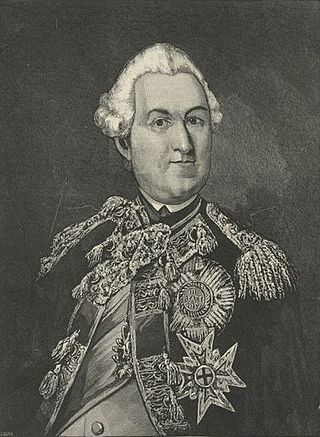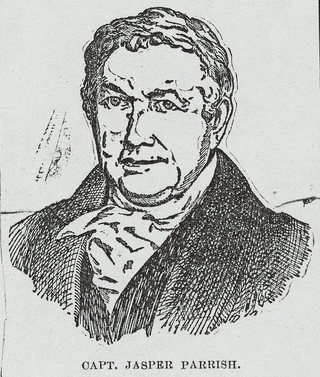
The Finger Lakes are a group of eleven long, narrow, roughly north–south lakes located directly south of Lake Ontario in an area called the Finger Lakes region in New York, in the United States. This region straddles the northern and transitional edge of the Northern Allegheny Plateau, known as the Finger Lakes Uplands and Gorges ecoregion, and the Ontario Lowlands ecoregion of the Great Lakes Lowlands.

Mythology of the Haudenosaunee includes the creation stories and folktales of the Native Americans who formed the confederacy of the Five Nations Iroquois, later the Six Nations Iroquois Confederacy. Historically, these stories were recorded in wampum and recited, only being written down later. In the written versions, the spellings of names differ due to transliteration and spelling variations in European languages that were not yet standardized. Variants of the stories exist, reflecting different localities and times.

Thayendanegea or Joseph Brant was a Mohawk military and political leader, based in present-day New York and, later, Brantford, in what is today Ontario, who was closely associated with Great Britain during and after the American Revolution. Perhaps the best known Native American of his generation, he met many of the most significant American and British people of the age, including both United States President George Washington and King George III of Great Britain.

Kateri Tekakwitha, given the name Tekakwitha, baptized as Catherine, and informally known as Lily of the Mohawks, is a Catholic saint and virgin who was an Algonquin–Mohawk. Born in the Mohawk village of Ossernenon, in present-day New York State, she contracted smallpox in an epidemic; her family died and her face was scarred. She converted to Catholicism at age nineteen. She took a vow of perpetual virginity, left her village, and moved for the remaining five years of her life to the Jesuit mission village of Kahnawake, just south of Montreal. She was beatified in 1980 by Pope John Paul II and canonized by Pope Benedict XVI at Saint Peter's Basilica on 21 October 2012.

The Phelps and Gorham Purchase was the sale, in 1788, of a portion of a large tract of land in western New York State owned by the Seneca nation of the Iroquois Confederacy to a syndicate of land developers led by Oliver Phelps and Nathaniel Gorham. The larger tract of land is generally known as the "Genesee tract" and roughly encompasses all that portion of New York State west of Seneca Lake, consisting of about 6,000,000 acres (24,000 km2).

John Abeel III known as Gaiänt'wakê or Kaiiontwa'kon in the Seneca language and thus generally known as Cornplanter, was a Dutch-Seneca chief warrior and diplomat of the Seneca people. As a war chief, Cornplanter fought in the American Revolutionary War on the side of the British. After the war Cornplanter led negotiations with the United States and was a signatory of the Treaty of Fort Stanwix (1784), the Treaty of Canandaigua (1794), and other treaties. He helped ensure Seneca neutrality during the Northwest Indian War.

Richard Coote, 1st Earl of Bellomont, known as The Lord Coote between 1683–89, was an Irish nobleman and colonial administrator who represented Droitwich in the English Parliament from 1688 to 1695. He was a prominent Williamite, supporting William III and Mary II during the Glorious Revolution.

Nebula Man is a fictional character in DC Comics. He first appeared in Justice League of America #100–101 (1972).
"I Shot Ya" is a song by American rapper LL Cool J featuring Keith Murray, from his sixth album Mr. Smith. The remix version, which featured Prodigy of Mobb Deep, Fat Joe, and Foxy Brown, of the song was released as a B-side to "Hey Lover", but received a video directed by Hype Williams, leading some to believe the track was an actual single from the album. Produced by Trackmasters, the remix was released in 1995 for Def Jam Recordings, and peaked at number 55 on the Hot R&B/Hip-Hop Songs for the Billboard charts.

The Schenectady massacre was an attack against the colonial settlement of Schenectady in the English Province of New York on February 8, 1690. A raiding party of 114 French soldiers and militiamen, accompanied by 96 allied Mohawk and Algonquin warriors, attacked the unguarded community, destroying most of the homes, and killing or capturing most of its inhabitants. Sixty residents were killed, including 11 Black slaves. About 60 residents were spared, including 20 Mohawk.

Turtle Island is a name for Earth or North America, used by some Indigenous peoples, as well as by some Indigenous rights activists. The name is based on a creation story common to several Indigenous peoples of the Northeastern Woodlands of North America.
Gendenwitha is a mythological character represented by the Morning Star in Iroquois mythology. Her name means "It Brings the Day." Gendenwitha was originally a beautiful maiden who was loved by Sosondowah, a great hunter held captive as a guard by Dawn. Dawn transformed Gendenwitha into the Morning Star after Sosondowah attempted to make her his bride.

The Iroquois, also known as the Five Nations, and later as the Six Nations from 1722 onwards; alternatively referred to by the endonym Haudenosaunee are an Iroquoian-speaking confederacy of Native Americans and First Nations peoples in northeast North America. They were known by the French during the colonial years as the Iroquois League, and later as the Iroquois Confederacy, while the English simply called them the "Five Nations". The peoples of the Iroquois included the Mohawk, Oneida, Onondaga, Cayuga, and Seneca. After 1722, the Iroquoian-speaking Tuscarora people from the southeast were accepted into the confederacy, from which point it was known as the "Six Nations".

Tutelo, also known as Tutelo–Saponi, is a member of the Virginian branch of Siouan languages that were originally spoken in what is now Virginia and West Virginia in the United States.

Kondiaronk, known as Le Rat, was Chief of the Native American Wendat people at Michilimackinac in New France. As a result of an Iroquois attack and dispersal of the Hurons in 1649, the latter settled in Michilimackinac. The Michilimackinac area is the strait between Lakes Huron and Michigan in the present-day United States.

Edward Cornplanter or So-son-do-wa (1856–1918) was a chief of the Seneca people of the Iroquois Nation (Haudenosaunee) and a leading exponent of the Code of Handsome Lake.

Jasper Parrish was a United States Agent and Interpreter for the Iroquois. Parrish was fluent in the Mohawk and Delaware languages after having lived among the Munsee and Mohawk nations for six years as a child. Parrish's residence with the Indian nations began when he and his father were kidnapped by members of the Munsee Indian nation on July 5, 1778.

Harriet Maxwell Converse was an American author of Scottish and Irish heritage. She was a folklorist, poet and historian of the Iroquois; by the late 19th century, they were a loose confederacy of six nations in New York State and Canada. She became an advocate for the rights of the Seneca and other Iroquois tribes in New York state, helping them retain their lands and preserve their culture. In recognition of her contributions, the Seneca made her a member of the tribe and gave her an honorary position as a Sachem or chief of the Six Nations.

Guy Maxwell was an Irish-born American pioneer. He was the first Internal Revenue Officer of the Elmira, New York region, and served as sheriff of Tioga County, Pennsylvania. He was the father and founder of the Maxwell family.
Hahgwehdiyu is the Iroquois god of goodness and light, as well as a creator god. He and his twin brother Hahgwehdaetgah, the god of evil, were children of Atahensic the Sky Woman, whom Hahgwehdaetgah killed in childbirth.

















